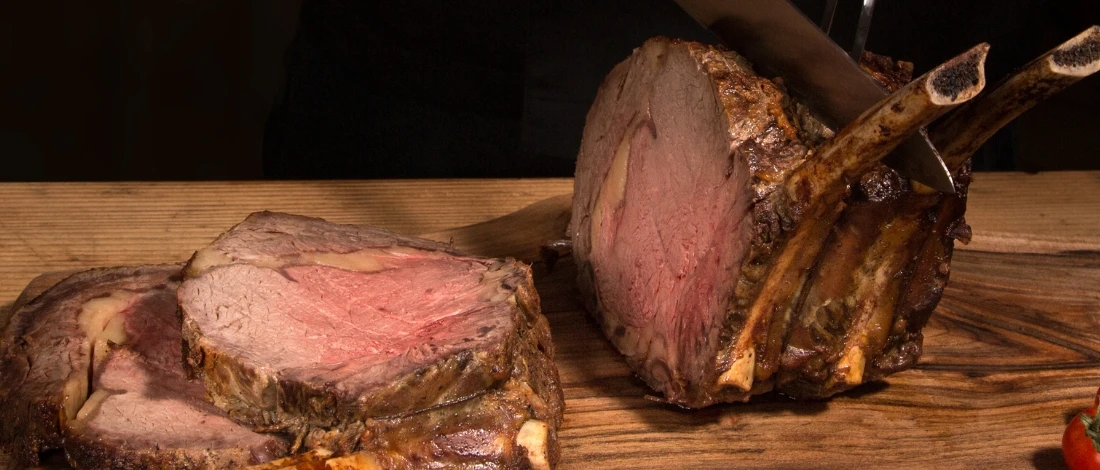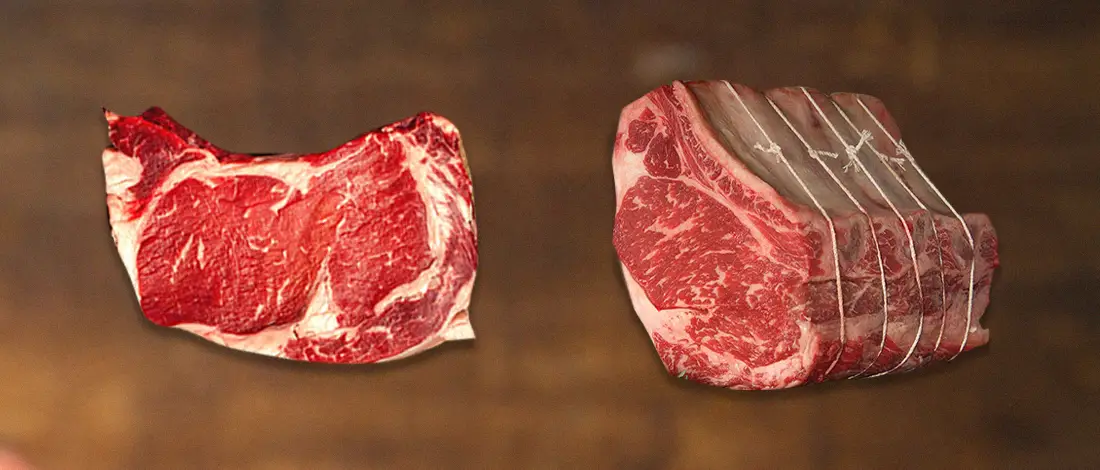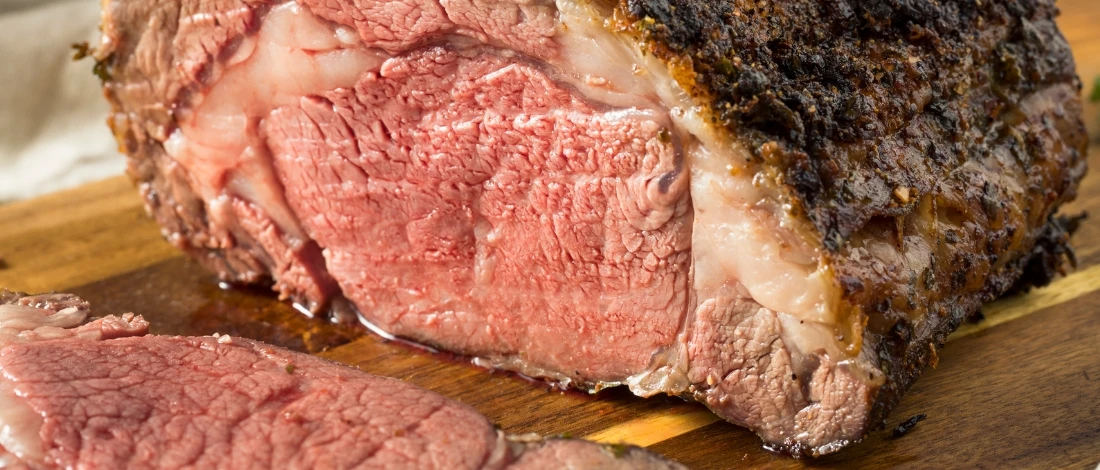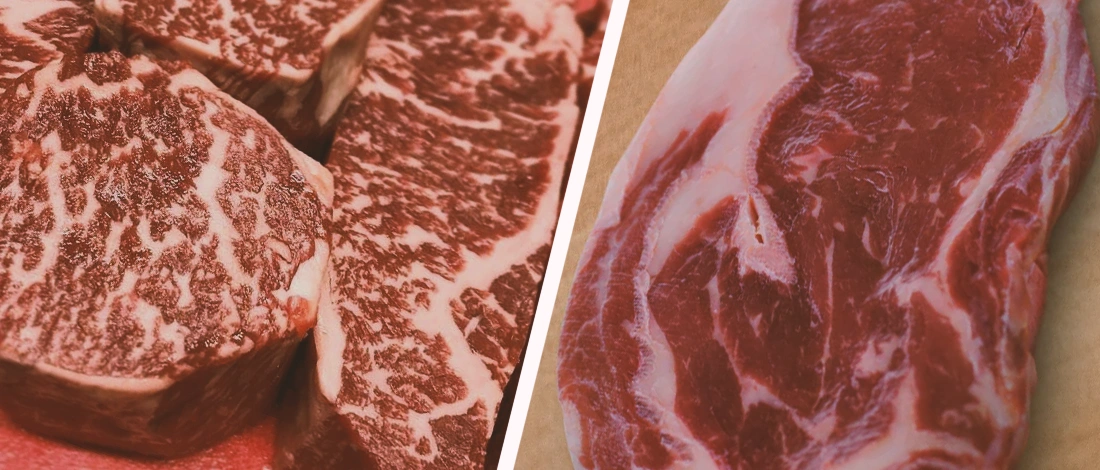As a 7-year keto-carnivore dieter, I always say that prime rib is my undisputed king of large beef cuts.
Whether hosting a family dinner or cooking for my friends, I enjoy serving slices or rosy and juicy prime meat over a bed of fresh veggie salad.
Today, I'll go into detail about what prime rib is, how to cook it, and what you need to keep in mind when buying this cut.
Let's get started.
Quick Summary
- Prime rib is derived from the 6 to 12-rib section of a cow.
- Prime rib roasts have a greater intramuscular fat degree; hence they have a richer meaty profile than other cuts.
- Roasting under direct heat is the best way to prepare prime rib to yield crispy and juicy slices.
What Is Prime Rib?

Prime rib is a cut from the cow's primal ribs. A cow has 13 ribs, and ribs 6 to 12 are sold as prime rib meat. And because it's composed of six ribs, it can weigh between 6-12 pounds.
The phrase "prime rib" refers to the meat cut rather than the grade. USDA Prime is the most expensive and has the greatest marbling.
Also Read: What Is Chicken Rib Meat?
What Does Prime Rib Taste Like?
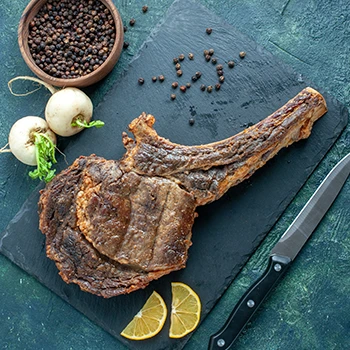
Prime rib tastes like steak but has a deep rich flavor typical of meat derived from the rib area. The flesh of a prime rib is soft and juicy because the muscles in this animal region are rarely utilized.
The considerable marbling and cap of fat contribute to a rich, flavorful medium-rare meat.
When you taste a perfectly cooked prime rib, you will understand why it is so expensive.
Although not all prime rib is cooked bone-in, the bone adds taste and moisture. The rib bones also simplify cooking the prime rib since they function as a natural slow roast rack.
Also Read: Prime Rib vs Ribeye Steak
The Texture of Prime Rib
As far as prime rib texture is concerned, it varies on how you prepare it and what your cooking methods are.
For example, some cooking methods, like boiling, do not generate the sear, which causes the texture of each mouthful to feel different on your tongue.
Similarly, broiling or slow-roasting will provide a different texture than grilling the primal rib.
What's the Best Way to Cook Prime Rib?

The best way to cook prime rib is roasting to brown the crust and melt the tasty fat. Because this tender meat contains a good fat content, roasting is a great way to render it down while it cooks to keep the steak tender.
To whole-roast your prime rib:
- Begin by salting and spicing the roast and refrigerating it for at least six or 24 hours. The salt seasoning accentuates the meaty taste of the rib while dissolving some of the proteins, resulting in a buttery-tender roast [1]. The salt and air exposure dry up the exterior, allowing for greater browning and crispiness.
- Place the same cut in a roasting pan, then roast it at a low heat temperature of 200 degrees for 4 to 5 hours or until it registers an internal temperature of 110 degrees, then turn off the heat.
- Leave the rib in the turned-off oven until the carryover cooking raises its temperature to 125 degrees for more tender meat.
- If you want a crusty exterior, a brief stint under the broiler for 6-10 minutes will do the trick. The high temperature yields a crispy surface and juicy meat in the center.
- Before slicing, the prime rib should rest for 30 minutes to allow the meat to reabsorb all the delectable natural juices. Remove the bones from the flesh and slice against the grain.
Tips For Buying Good Prime Rib Meat

When buying prime rib meat, consider these five key things.
1. Quality
For the highest quality, go for a USDA prime-grade roast.
This is the highest quality meat and the most costly one. I recommend it if you want a soft beef cut with the most marbling and richer taste.
2. Marbling Color
Select a rib roast with vibrant color and milky white fat. Avoid dark-colored meat with dull fat. Look for uniform fat distribution and a thick coating of fat around the ends as well.
I wouldn't recommend getting leaner cuts when shopping for prime rib meat.
3. Bone-In or Boneless
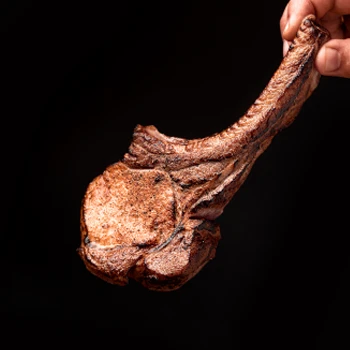
In my experience, a bone-in-standing rib roast has more juice and flavor, but a boneless roast is less expensive.
A typical standing rib roast is served with the bones in the flesh, so if you plan on displaying the roast on a table for all to see, get a bone-in roast.
I always prefer to ask the butcher to remove the flesh and tie it to the bone with a butcher's twine–this eases my preparation and carving steps after cooking it.
4. Size and Quantity
Determine the quantity and size of meat you will require for your guests. My rule of thumb is to go with one pound of boneless prime rib for one person. Each rib should weigh between two and three pounds for a standing roast.
Also, if possible, go with bigger primal ribs in terms of size.
"Bigger prime ribs cook well and absorb spice flavors better than smaller cuts which are prone to drying out and burning."
- Natasha Kravchuk, Executive Chef
Related Articles:
Should You Leave the String on Prime Rib?
Yes, you should leave the string on when you cook prime rib or a standing rib roast. This is particularly true if you buy meat without rib bones (chine bones).
However, this method is not without some controversy.
If not correctly applied, the string can create pressure around the outer surface of the roast. This may cause some portions of the meat to be flattened, leading to uneven cooking. Tying too tightly can also force some of the juices out of the prime rib, thus compromising its flavor.
Another disadvantage of leaving the string on the prime rib is that removing it after cooking can be challenging and frustrating. This can make carving this premium cut of meat more difficult and time-consuming.
The string can also leave an indentation in the finished prime rib, affecting the roast's appearance. This may not be a concern for everyone, but it is something to consider for those who prioritize presentation.
How Long Does Prime Rib Last in the Fridge?
Uncooked prime rib can last in the fridge for up to five days, while cooked prime rib can last up to four days.
These estimates are based on what the United States Department of Agriculture (USDA) recommends for the maximum time that cooked or uncooked meat should be stored properly in the fridge to stay fresh.
If you are not planning to consume the prime rib within this timeframe, it is best to freeze it to prevent spoilage [2].
It's important to note that these estimates are not a guarantee. For example, the length of time that cooked prime rib lasts in the fridge can vary depending on factors such as the quality of the meat and how it was stored. The same is true for storing uncooked prime rib so that it stays fresh.

To ensure that a standing rib roast lasts as long as possible in the fridge, it's important to refrigerate it properly.
Here are some tips to keep in mind:
- Make sure the prime rib is completely dry before storing it. You can pat it down with paper towels to remove any excess moisture.
- Refrigerate cooked prime rib between 33°F and 40°F. This is the ideal temperature range for storing meat, as it slows down the growth of bacteria that can cause spoilage.
- Wrap the prime rib tightly in plastic wrap or aluminum foil. You can also use an air-tight container or vacuum-sealed plastic bag. This will help protect the meat from exposure to air, which can cause it to spoil more quickly and dry out.
- Store cooked prime rib on the bottom shelf of the fridge. This is the coldest part of the fridge and will help keep the meat at a safe temperature.
- Avoid storing cooked meat and raw prime rib together in the same location. This increases the risk of cross-contamination and may become a breeding ground for bacteria to spread.
"Refrigeration slows but does not prevent bacterial growth. Therefore, it's important to use food in a timely fashion before it spoils or becomes dangerous."
- U.S. Department of Agriculture
FAQs
Are Ribeye and Prime Rib the Same?
No, ribeye and prime rib are not the same, even though they come from the same primal cut. The main difference is in their cooking methods, texture and taste.
Which Is More Expensive, Prime Rib or Ribeye?
Prime rib is more expensive than ribeye because of the large 'eye' of meat at the center of it. This renders prime meat more juicy, tender, and marbled than bone-in ribeye steak.
Is Prime Beef Rib a Good Cut of Meat?
Yes, prime beef rib is a good cut of meat because of its generous marbling degree that enriches its meat flavor profile.
How Far in Advance Can You Buy a Prime Rib?
You can buy prime rib 5 days in advance of cooking it if you store it properly. But it's best to use or freeze it within a few days of purchase for optimal freshness.
Why Does Prime Rib Turn Brown in the Fridge?
Prime rib turns brown in the fridge due to oxidation. If the prime rib is still within the safe temperature range, hasn’t been stored for an extended period, and doesn’t exhibit an off smell or slimy texture, it should still be safe to cook and consume.
Can You Smoke Prime Rib With Strings?
Yes, you can smoke prime rib with strings. Just as with a roasted prime rib, the string will enhance the juiciness and texture of the meat.
Reference:
- https://www.ncbi.nlm.nih.gov/pmc/articles/PMC7171045/
- https://ask.usda.gov/s/article/How-long-can-I-keep-meat-in-the-refrigerator


